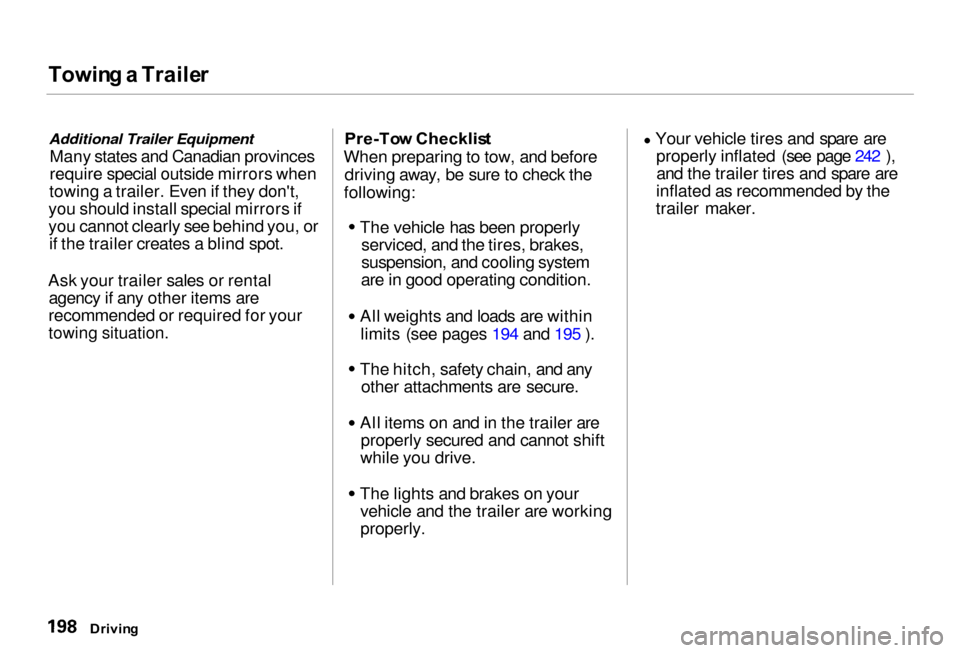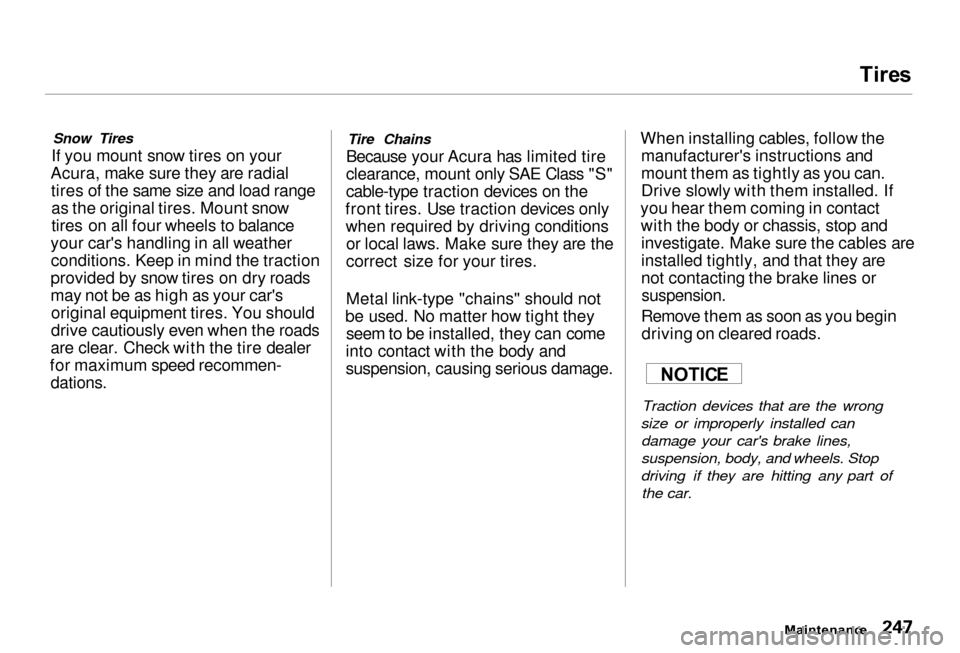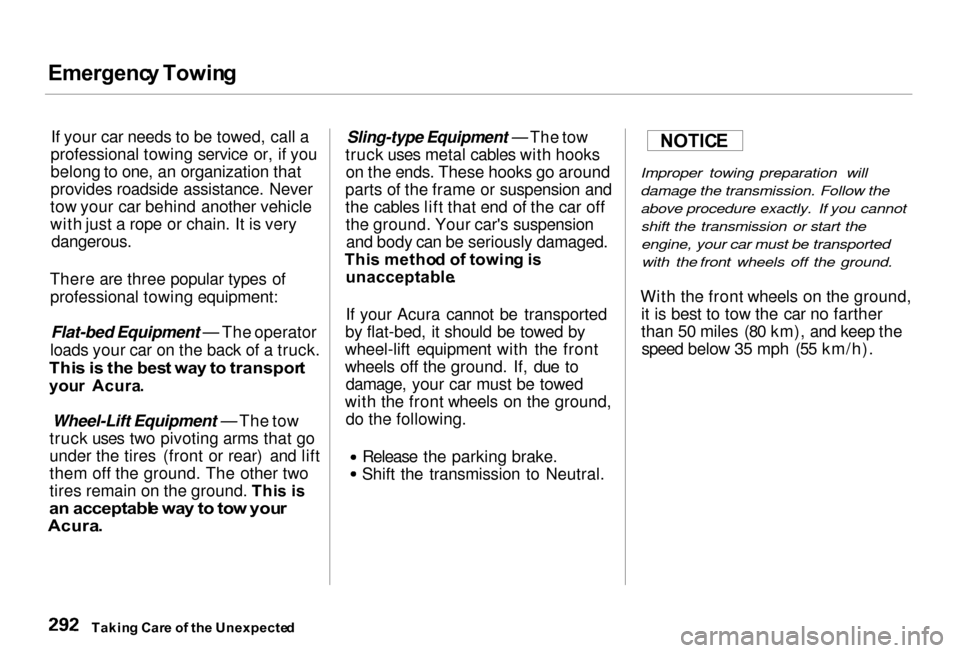suspension Acura RL 2000 3.5 Owner's Manual
[x] Cancel search | Manufacturer: ACURA, Model Year: 2000, Model line: RL, Model: Acura RL 2000Pages: 330, PDF Size: 4.53 MB
Page 201 of 330

Towin
g a Traile r
Additional Trailer Equipment Many states and Canadian provinces
require special outside mirrors when
towing a trailer. Even if they don't,
you should install special mirrors if
you cannot clearly see behind you, or if the trailer creates a blind spot.
Ask your trailer sales or rental agency if any other items are
recommended or required for your
towing situation.
Pre-To
w Checklis t
When preparing to tow, and before driving away, be sure to check the
following: The vehicle has been properly
serviced, and the tires, brakes,
suspension, and cooling system
are in good operating condition.
All weights and loads are within limits (see pages 194 and 195 ).
The hitch, safety chain, and any other attachments are secure. All items on and in the trailer are
properly secured and cannot shift
while you drive. The lights and brakes on your
vehicle and the trailer are working
properly. Your vehicle tires and spare are
properly inflated (see page 242 ),and the trailer tires and spare are
inflated as recommended by the
trailer maker.
Drivin g
Page 250 of 330

Tire
s
Snow Tires
If you mount snow tires on your
Acura, make sure they are radial tires of the same size and load rangeas the original tires. Mount snow
tires on all four wheels to balance
your car's handling in all weather conditions. Keep in mind the traction
provided by snow tires on dry roads
may not be as high as your car's original equipment tires. You should
drive cautiously even when the roads
are clear. Check with the tire dealer
for maximum speed recommen-
dations.
Tire Chains
Because your Acura has limited tire
clearance, mount only SAE Class "S"
cable-type traction devices on the
front tires. Use traction devices only when required by driving conditionsor local laws. Make sure they are the
correct size for your tires.
Metal link-type "chains" should not
be used. No matter how tight they seem to be installed, they can come
into contact with the body and
suspension, causing serious damage. When installing cables, follow the
manufacturer's instructions and
mount them as tightly as you can.
Drive slowly with them installed. If
you hear them coming in contact with the body or chassis, stop andinvestigate. Make sure the cables are
installed tightly, and that they are
not contacting the brake lines or
suspension.
Remove them as soon as you begin driving on cleared roads.
Traction devices that are the wrong
size or improperly installed can damage your car's brake lines,
suspension, body, and wheels. Stop
driving if they are hitting any part of the car.
Maintenance
NOTIC
E
Page 295 of 330

Emergenc
y Towin g
If your car needs to be towed, call a
professional towing service or, if you
belong to one, an organization that
provides roadside assistance. Never
tow your car behind another vehicle
with just a rope or chain. It is very
dangerous.
There are three popular types of professional towing equipment:
Flat-bed Equipment — The operator
loads your car on the back of a truck.
Thi s is th e bes t wa y to transpor t
you r Acura .
Wheel-Lift Equipment — The tow
truck uses two pivoting arms that go
under the tires (front or rear) and lift
them off the ground. The other two
tires remain on the ground. Thi s i s
a n acceptabl e wa y to to w you r
Acura .
Sling-type Equipment — The tow
truck uses metal cables with hooks on the ends. These hooks go around
parts of the frame or suspension and
the cables lift that end of the car off the ground. Your car's suspensionand body can be seriously damaged.
Thi s metho d o f towin g is
unacceptable .
If your Acura cannot be transported
by flat-bed, it should be towed by
wheel-lift equipment with the front
wheels off the ground. If, due to damage, your car must be towed
with the front wheels on the ground, do the following. Release the parking brake.
Shift the transmission to Neutral.
Improper towing preparation will
damage the transmission. Follow the
above procedure exactly. If you cannot
shift the transmission or start theengine, your car must be transportedwith the front wheels off the ground.
With the front wheels on the ground, it is best to tow the car no farther
than 50 miles (80 km), and keep thespeed below 35 mph (55 km/h).
Takin g Car e o f th e Unexpecte d
NOTIC
E